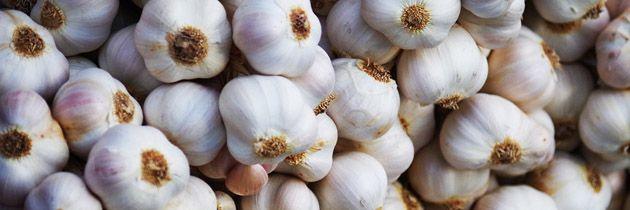QUICK FACTS
Scientific name: Allium sativum
Other names: Allium, stinking rose, nectar of the gods, camphor of the poor
Location: Native to Central Asia, cultivated worldwide
Known for: Its pungent flavor and broad-spectrum antimicrobial qualities
Part Used: Cloves
Fun fact: Garlic can be used as a natural insecticide to protect a garden from pests.
Good for: Microbiome balance, gut health, cardiovascular support, immune support
Key Properties & Actions: antibacterial, antiviral, antifungal, antiparasitic, anti-inflammatory, antioxidant, hypotensive, vasodilator, circulatory stimulant, immunomodulator, blood thinner, hypocholesterolemic, expectorant
What is Garlic?
Garlic is a perennial, bulb-forming plant of the Amaryllidaceae family, which includes other familiar vegetables of the Allium genus like onions, leeks, and chives.
The bulb of garlic is generally made up of six to 10 smaller bulblets, more commonly referred to as cloves. The cloves and bulb are covered in a white to purple skin that becomes papery when dry.
Above ground, garlic grows wide, linear leaves and a flowering stem, at the top of which sits white to purple flowers.
Since the beginning of recorded history, garlic has been recognized for its health benefits. It contains a variety of biologically-active compounds, but the most well-studied is a sulfuric compound called allicin.
Garlic exhibits impressive actions that support the body’s microbiome, gut, cardiovascular system, and immune system. In addition to its medicinal qualities, it is a time-honored ingredient in cuisines and dishes across the world..
Benefits of Garlic and How It Works
Broad-Spectrum Antimicrobial
Garlic is an impressive antimicrobial herb that shows broad-spectrum activity against bacteria such as Escherichia coli, Staphylococcus aureus, Streptococcus mutans, and Salmonella enterica. This is attributed to allicin, a sulfuric compound within garlic that is responsible for its distinct scent and flavor.1
Modern antibiotics present many challenges, including unwanted symptoms and the emergence of antibiotic-resistant bacteria. Impressively, garlic has demonstrated the ability to fight some antibiotic-resistant bacteria.1
Additionally, garlic possesses antiviral capabilities. A 2020 systematic review concluded garlic has potent antiviral activity that can help ward off potential infections. Garlic is able to do this through mechanisms like blocking viral entry into the host’s cells, inhibiting viral replication, and enhancing the host’s immune response.2
Garlic also has antifungal properties and can be consumed internally or applied topically for fungal infections like candida.3
Balances Gut Microbiome
Garlic’s antimicrobial actions are passed along to the gut when consistently consumed. It can help suppress pathogens like H. pylori and candida, while encouraging the growth of beneficial microbes.3,4
A 12-week animal study suggested garlic could protect gut microbiome diversity, as well as promote the renewal and growth of cells that line the digestive tract.5
Cardiovascular Support
Garlic has been utilized for cardiovascular support for thousands of years. Modern research shows that it can lower blood pressure, relax blood vessels, reduce cholesterol, and inhibit platelet aggregation (stickiness).1,3,6
A 2016 review of human clinical trials concluded that garlic supplementation has the potential to protect the cardiovascular system based on its ability to reduce blood pressure, cholesterol, and atherosclerosis markers.7
Immune Health
Garlic has a balancing effect on the immune system — it boosts its ability to fight infections, while calming overactive portions associated with destructive inflammation.3,8,9
In a placebo-controlled clinical trial, garlic capsules administered for 12 weeks were associated with fewer occurrences of the common cold than the placebo group.10
In the last few decades, interest in garlic’s anticancer properties has increased. Prostate and gastrointestinal cancers have been shown to be less common among individuals who eat more garlic.8 Mechanistic studies provide evidence that garlic and its compounds like allicin can positively alter the behavior of tumors and precancerous cells.8,11
History & Traditional Use
Garlic is believed to have originated in the high plains of Central Asia, but it has been cultivated and used medicinally for thousands of years across many different lands.
In Ancient Egypt, records dating back to 1550 BC document the medicinal uses of garlic as a natural remedy for parasites, high blood pressure, headaches, and tumors. It appeared in the Ebers Papyrus, an Egyptian medical text, and was listed as an ingredient in 22 medicinal preparations.3,8 In Ancient Greece and Rome, garlic was used for parasites as well as a cough suppressant.
In China, garlic is considered food and medicine, with its first documentation appearing around 510 CE. During this time, it was used for the common cold, digestive disorders, and even applied topically.3
In Ayurveda, a traditional medicine system of India, garlic has been used for over 3000 years and is thought to strengthen the heart and support the blood.6
How to Use and Dosing
Garlic is most often consumed as a food, but it can be taken as an encapsulated extract to maximize its benefits.
Garlic’s beneficial phytochemical allicin is very volatile and breaks down quickly once garlic is crushed. Less than 1% of this compound is absorbed from consumed garlic. Encapsulated garlic extracts dramatically increase allicin yield by dehydrating garlic under low heat to preserve the compounds and then encapsulating it so that the allicin is not released until the capsule dissolves in the intestinal tract.
The general dosage for garlic (allicin) is 180-1200 mg, two to three times daily. The dosage is dependent on the garlic preparation used.
For antimicrobial purposes, garlic may be used with herbs like andrographis, Japanese knotweed, Chinese skullcap, berberine, prickly ash, and cat’s claw.
For cardiovascular support, garlic is often used with hawthorn, pine bark extract, resveratrol-rich Japanese knotweed, milk thistle, and omega-3 fatty acids such as those found in krill oil.
Garlic can also be infused into oil for topical use. It is commonly prepared in this way for ear discomfort. In this case, 2-3 drops of the infused oil are placed in the ear canal up to three times daily.
Culinary Use
Garlic is a prized ingredient across many culinary traditions, lending its flavorful character to any dish it accompanies. It is especially prominent in Mexican, Indian, Asian, Greek, and Italian cuisines.
Although garlic can be taken in a medicinal form, such as an encapsulated extract, there are many other preparations that are easy and enjoyable to make at home.

Garlic is a perfect addition to broth. Add whole or chopped cloves to the broth and simmer for at least 30 minutes; the longer they are simmered, the milder and sweeter their flavor becomes. The garlic can be left in the broth or strained out.
Another popular culinary use of garlic is adding it to sauces. Pesto is an Italian-based garlic sauce, which also features basil and olive oil.
To make pesto:
- Process 2 cups of basil, 2 tablespoons of pine nuts or walnuts, and 2 cloves of garlic in a food processor.
- Once finely minced, slowly pour 2 cups of extra-virgin olive oil into the food processor while it runs on low.
- When the mixture is smooth, a ½ cup of freshly grated parmesan cheese can be added and briefly processed.
- Pesto can be stored in the refrigerator or freezer.
Other sauces that feature garlic include gremolata, aioli, and skordalia. Garlic can also be found in the Middle Eastern side dish, hummus.
Homemade fermented foods like kimchi or sauerkraut can benefit from the addition of fresh garlic. Adding 2-3 cloves to a lacto-fermented recipe can encourage the growth of beneficial bacteria and inhibit the growth of unwanted microbes.
Interactions
Garlic has blood thinning properties, so it should be avoided before and after surgery. Consult your health care practitioner if you are taking blood-thinning medications.
Always check with your health care practitioner before use if you are taking medications. For more general education on potential interactions between herbs and medications, check out Dr. Bill Rawls’ article: Is it Safe to Take Herbs with My Medications?
Precautions & Side effects
Raw garlic can cause stomach upset, although encapsulated garlic extracts are generally well tolerated.
Disclaimer: This information is intended only as general education and should not be substituted for professional medical advice. Any mentioned general dosage options, safety notices, or possible interactions with prescription drugs are for educational purposes only and must be considered in the context of each individual’s health situation and the quality and potency of the product being used. Use this information only as a reference in conjunction with the guidance of a qualified healthcare practitioner.
Want to See the Science? Check Out Our References Below.
1. El-Saber Batiha G, Magdy Beshbishy A, G Wasef L, et al. Chemical Constituents and Pharmacological Activities of Garlic (Allium sativum L.): A Review. Nutrients. 2020;12(3):872. Published 2020 Mar 24. doi:10.3390/nu12030872
2. Rouf R, Uddin SJ, Sarker DK, et al. Antiviral potential of garlic (Allium sativum) and its organosulfur compounds: A systematic update of pre-clinical and clinical data. Trends Food Sci Technol. 2020;104:219-234. doi:10.1016/j.tifs.2020.08.006
3. Christa S. In: The Essential Guide to Western Botanical Medicine. Arcata, CA: Christa Sinadinos; 2020:221-225.
4. Zardast M, Namakin K, Esmaelian Kaho J, Hashemi SS. Assessment of antibacterial effect of garlic in patients infected with Helicobacter pylori using urease breath test. Avicenna J Phytomed. 2016;6(5):495-501.
5. Chen K, Xie K, Liu Z, et al. Preventive Effects and Mechanisms of Garlic on Dyslipidemia and Gut Microbiome Dysbiosis. Nutrients. 2019;11(6):1225. Published 2019 May 29. doi:10.3390/nu11061225
6. Aggarwal, B. and Yost, D., 2011. Healing spices. New York: Sterling Pub. Co., pp.127-134.
7. Varshney R, Budoff MJ. Garlic and Heart Disease. J Nutr. 2016;146(2):416S-421S. doi:10.3945/jn.114.202333
8. Nicastro HL, Ross SA, Milner JA. Garlic and onions: their cancer prevention properties. Cancer Prev Res (Phila). 2015;8(3):181-189. doi:10.1158/1940-6207.CAPR-14-0172
9. Ban JO, Oh JH, Kim TM, et al. Anti-inflammatory and arthritic effects of thiacremonone, a novel sulfur compound isolated from garlic via inhibition of NF-kappaB. Arthritis Res Ther. 2009;11(5):R145.
10. Lissiman E, Bhasale AL, Cohen M. Garlic for the common cold. Cochrane Database Syst Rev. 2014;2014(11):CD006206. Published 2014 Nov 11. doi:10.1002/14651858.CD006206.pub4
11. Zhang Y, Liu X, Ruan J, Zhuang X, Zhang X, Li Z. Phytochemicals of garlic: Promising candidates for cancer therapy. Biomed Pharmacother. 2020;123:109730. doi:10.1016/j.biopha.2019.109730





